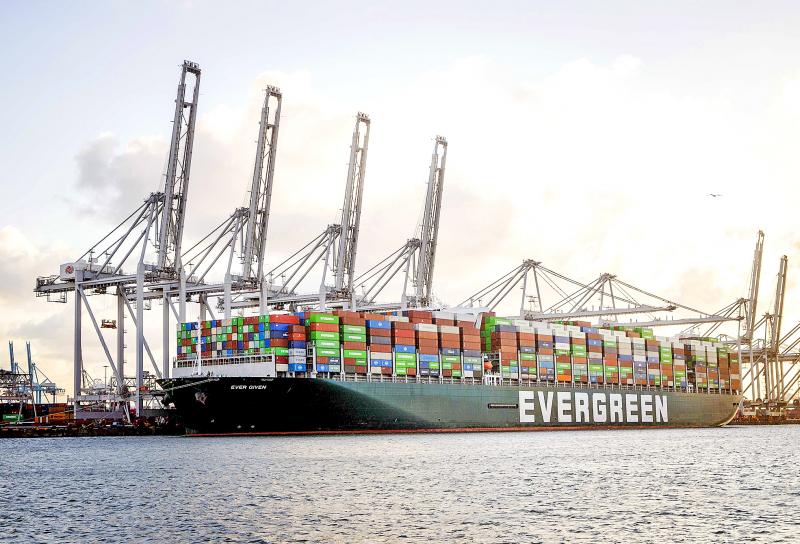European manufacturers are increasingly strained by global supply-chain problems that are pushing up prices and could last well into next year.
A gauge by IHS Markit measuring business activity in manufacturing fell last month by the biggest margin since April last year — the beginning of the COVID-19 pandemic. Growth in new orders, output and employment slowed considerably.
“Supply issues continue to wreak havoc across large swathes of European manufacturing, with delays and shortages being reported at rates not witnessed in almost a quarter of a century and showing no signs of any imminent improvement,” IHS Markit chief business economist Chris Williamson said in a statement.

Photo: EPA-EFE
Price pressures remained close to record levels, and companies passed on rising production costs to customers at a faster rate to protect their profit margins.
European-area inflation is expected to have quickened to above 3 percent last month, well exceeding the European Central Bank’s 2 percent target. While most officials insist that the spike is temporary, lasting supply-chain problems are seen as a key risk that could entrench higher price growth.
Reports from Asia give room for some optimism that bottlenecks could soon be cleared. Manufacturing activity there rebounded last month after COVID-19’s grip on several countries loosened, allowing the easing of lockdown measures that had shut down factories.
Activity in Asia’s manufacturing sector stagnated broadly last month as pandemic-induced factory shutdowns and signs of slowing Chinese growth weighed on the region’s economies, surveys showed yesterday.
Countries where large outbreaks of the Delta variant of SARS-CoV-2 receded saw an improvement in activity, such as Indonesia and India.
However, factory activity last month shrank in Malaysia and Vietnam, and grew in Japan at the slowest rate in seven months, as chip shortages and supply disruptions added to the woes of a region still struggling to shake off the hit from the pandemic.
China’s waning economic momentum dealt a fresh blow to the region’s growth prospects, with the official Purchasing Manager’s Index on Thursday showing that the country’s factory activity unexpectedly shrank last month due to wider restrictions on electricity use.
“While coronavirus curbs on economic activity may be gradually lifted, the slow pace at which this will happen means Southeast Asian economies will stagnate for the rest of this year,” NLI Research Institute economist Makoto Saito said.

CHIP RACE: Three years of overbroad export controls drove foreign competitors to pursue their own AI chips, and ‘cost US taxpayers billions of dollars,’ Nvidia said China has figured out the US strategy for allowing it to buy Nvidia Corp’s H200s and is rejecting the artificial intelligence (AI) chip in favor of domestically developed semiconductors, White House AI adviser David Sacks said, citing news reports. US President Donald Trump on Monday said that he would allow shipments of Nvidia’s H200 chips to China, part of an administration effort backed by Sacks to challenge Chinese tech champions such as Huawei Technologies Co (華為) by bringing US competition to their home market. On Friday, Sacks signaled that he was uncertain about whether that approach would work. “They’re rejecting our chips,” Sacks

Taiwan’s exports soared 56 percent year-on-year to an all-time high of US$64.05 billion last month, propelled by surging global demand for artificial intelligence (AI), high-performance computing and cloud service infrastructure, the Ministry of Finance said yesterday. Department of Statistics Director-General Beatrice Tsai (蔡美娜) called the figure an unexpected upside surprise, citing a wave of technology orders from overseas customers alongside the usual year-end shopping season for technology products. Growth is likely to remain strong this month, she said, projecting a 40 percent to 45 percent expansion on an annual basis. The outperformance could prompt the Directorate-General of Budget, Accounting and

NATIONAL SECURITY: Intel’s testing of ACM tools despite US government control ‘highlights egregious gaps in US technology protection policies,’ a former official said Chipmaker Intel Corp has tested chipmaking tools this year from a toolmaker with deep roots in China and two overseas units that were targeted by US sanctions, according to two sources with direct knowledge of the matter. Intel, which fended off calls for its CEO’s resignation from US President Donald Trump in August over his alleged ties to China, got the tools from ACM Research Inc, a Fremont, California-based producer of chipmaking equipment. Two of ACM’s units, based in Shanghai and South Korea, were among a number of firms barred last year from receiving US technology over claims they have

BARRIERS: Gudeng’s chairman said it was unlikely that the US could replicate Taiwan’s science parks in Arizona, given its strict immigration policies and cultural differences Gudeng Precision Industrial Co (家登), which supplies wafer pods to the world’s major semiconductor firms, yesterday said it is in no rush to set up production in the US due to high costs. The company supplies its customers through a warehouse in Arizona jointly operated by TSS Holdings Ltd (德鑫控股), a joint holding of Gudeng and 17 Taiwanese firms in the semiconductor supply chain, including specialty plastic compounds producer Nytex Composites Co (耐特) and automated material handling system supplier Symtek Automation Asia Co (迅得). While the company has long been exploring the feasibility of setting up production in the US to address